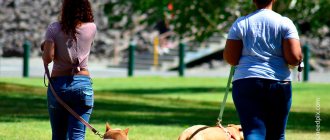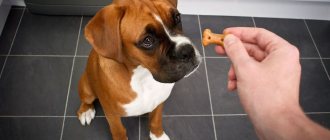The fear of any new dog owner: Once I get a dog, I will forget about sleep and will be forced to walk the dog early in the morning every day. The good news is that over many years of living with humans, pets have learned to adapt to their owner’s lifestyle. You can easily accustom your dog to a schedule that you are used to. The main thing is to follow the pet’s daily routine and not force the dog to endure it for more than 12 hours.
“The most important thing is to remember that the dog’s daily routine should be more or less constant. If you want to sleep longer, just go for a walk later the day before, for example, at 10 pm. For an adult dog, it doesn’t matter whether you walk it at 5 in the morning or at 10, it is important that the break between walks is no more than 12 hours,” commented Vladimir GOLUBEV, President of the Russian Canine Federation.
If the dog refuses to pee outside
A dog may be comfortable walking to relieve itself in an apartment, so it may specifically endure a walk in order to relieve itself at home. In this regard, the following recommendations should be made:
- Find your dog a walking buddy. While walking outside, dogs will frolic, which will make you feel the urge to go to the toilet. Also, another dog can become an example, and your pet will begin to repeat after it, mark its territory and defecate.
- Take water. When the dog has run around enough, he will want to drink. Pour water into her bowl and let her drink. The abundance of liquid will force the dog to do the deed outside.
- Play with the dog. The more the dog runs and frolics, the faster it will want to go to the toilet. Come up with outdoor games to keep your dog moving as much as possible. This will also lead to the desire to empty the bowels and bladder. After this, be sure to praise your pet.
- Increase your walking time. The dog cannot endure for long if there is every opportunity to go to the toilet. Therefore, walk your dog longer until he gives up and sits down.
Using these tips has helped many dog owners teach their pet to go outside when needed. Never give up and stay consistent. The dog will always respond to your care and love. Let your pet be the most obedient and “cleanest” friend of the family!
Age factor
A good way to estimate how long a dog can go without going to the toilet, other than making a mess, is to use a general formula based on age: add 1 to the age in months to get a rough estimate of how long he can hold the bladder. For example, a 3-month-old puppy can hold a bladder for about four hours . Keep in mind that small breeds have small bladders and may not be able to go that long without going to the toilet. At 6 months of age, measuring this duration will not be necessary as your dog will likely be able to hold the bladder for up to ten hours . This is the maximum even for adult dogs.
© shutterstock
Health
Many health conditions can cause you to urinate more frequently. Urinary tract problems, kidney problems, diabetes and even weight problems can be a factor.
Medicines also play a role. Some medications may have a diuretic effect, meaning they encourage more frequent urination.
If you have concerns that your pet is urinating more than usual, it is important to talk to your veterinarian. This may be a symptom of a health problem that needs to be addressed.
Size
The size of your pet is also an important factor. A small dog has a very tiny bladder compared to a large dog. This does not mean that more dogs are able to go longer without using the toilet, but it may contribute to success in potty training and indoor training.
It is estimated that dogs pee approximately 20-30 ml per 1 kg of weight. Therefore, a dog weighing 3 kg will urinate between 60-30 ml per day. It's not much, but how much can their tiny bladders hold? 15 mg, 30 at best.
Every dog is different, and their bathroom habits are unique too. Our recommendations are general estimates, but your dog can live significantly less without using the toilet. Make sure you create a bathroom schedule that best suits your puppy.
Effective ways to fight
There is enough advice on how to wean a dog from relieving itself in an apartment or house.
We have tried to carefully consider these recommendations and provide you with the most effective ways to deal with such an unpleasant situation.
Basic Rules
- Never yell at your pet (during and after the “crime”). If you start screaming after the dog has taken a shit, then it will take note that it is forbidden to take a shit in front of you and will hide from you in order to do the harm.
- Never hit your puppy or rub his nose into the pile. This offends the pet, and he does not understand why he is being punished after the fact. This may cause the dog to eat its own excrement in fear.
- Always be consistent and constant. If you want to teach your dog to go to the toilet outside, you need to do this regularly at the same time. If one day you took the dog out, and the next you were lazy or couldn’t, and then came and scolded the pet, he definitely won’t understand what you demand from him.
- Always reward your dog after he goes to the toilet. When you go for a walk with your dog, grab a couple of dog treats. After the “accomplished action”, reward your pet and be sure to praise it by stroking the withers.
Find out what the normal temperature is for dogs. Find out how to measure your pet's temperature in our article.
How to create a convenient walking schedule
Getting up early to walk your dog is a myth that is more likely to be used as an argument against buying a dog. Everyone thinks that having a pet is a test of endurance that will have to be passed every day. In real life, the dog will happily lie with you longer if it is accustomed to this. If no more than 12 hours pass between walks, the animal will calmly wait for a walk at a time convenient for you.
For all dogs, it is not the early morning walks that are important, but the rituals themselves. They do not adjust their biological rhythms to the rising or setting of the sun. Dogs prefer to follow certain learned patterns. If your pet is used to waking you up early in the morning, and you obediently get up and go for a walk, then most likely he will always continue to do this and not even because he really needs to go to the toilet, he just has a simple scheme in his head: I wake up the owner - He gets up and takes me for a walk. It’s not as important to take a walk at 6 o’clock in the morning as it is to comply with a behavioral pattern. Therefore, such behavior must be stopped immediately and the dog must understand that he goes for a walk only when you indicate the time. For example, you want to walk your dog at 10 am. To do this, the evening walk should be no earlier than 10 pm. In the morning after the alarm clock, you get up and put a collar on the dog - if you repeat these actions many times, the dog will understand that the alarm signal and the collar will mean that he will soon go for a walk. And then the pet will not wake you up to go for a walk, he will simply wait for the alarm signal and his collar.
It is important to create a personalized schedule that suits both you and your dog. The regime is very important for the animal. Do not forget about consistency, the animal should approximately understand when it is taken for a walk, the body in this case will adapt to the regime, and this will not lead to problems with internal organs. Constant restraint is fraught with inflammation of the bladder and other diseases of the urinary tract and digestive system.
Remember that walking is necessary for a dog not only to satisfy physiological needs. Walking is an important part of socialization. On walks, you strengthen your emotional connection with your pet, allowing him to develop and explore new things. To make your life with your dog enjoyable, try to maintain balance by creating a life schedule that is convenient for both of you.
How to stop an adult dog from shitting at home
In general, you need to act, just like with a puppy. Yelling at a dog, hitting it and poking its nose into a puddle is useless. You just need to take her out on the street more often and every time she relieves herself there, praise her in a kind voice.
If a dog has done its dirty work at home in front of its owner, it needs to be punished. You can hit, but not with a heavy object or hand, you need to do it with a newspaper folded into a tube or a broom, that is, with an object that is more intimidating than painful. Dogs are very emotional, it is enough for them to understand that the owner is upset or angry, and pain rarely frightens them, only makes them angry. If a dog starts to shit at home, what is the reason, you must understand elno. A dog will not simply give up the habit of relieving itself on the street. Moreover, by solving this issue, the owner can automatically solve this problem.
How many times do dogs go to the toilet?
We have determined how long a dog can go without going to the toilet. However, now we need to figure out how many times a day a dog should go to the toilet. I think this question is no less important, because it will help us understand when something is wrong with our dog, as well as how many times a day we need to walk it. So let's get down to specifics.
On average, dogs need to go outside at least 3 to 5 times a day to be able to go to the toilet. Veterinarians recommend that adult dogs take bathroom breaks no more than 6-8 hours.
Causes of urinary incontinence in dogs
First of all, we must understand that urinary incontinence in a dog is not a disease, but only a symptom that signals us about some problems in the pet’s body. But there can be many reasons for such an unpleasant phenomenon. Let's start with the most harmless one.
Sometimes a person who has adopted a male dog for the first time in his life simply does not know that they tend to mark their territory and raise their paw literally under every tree, post, wall, etc. This is completely normal (on the contrary, if an adult uncastrated male does not do this, one can think of weakened sexual functions). And, of course, you need to be prepared for the fact that the puppy will make puddles at home for up to 4-5 months. In other cases, we can talk about some pathologies.
Sometimes involuntary urination occurs in dogs due to strong emotions. It could be fear or joy. Breeds such as Russian Toy, Chihuahua and other miniature dogs are especially susceptible to this. Of the large breeds, German Shepherds, Doberman Pins, and Boxers are predisposed to incontinence. This phenomenon is also often observed in older dogs, since the bladder sphincter muscles weaken with age.
But more often the cause of urinary incontinence in dogs is internal disorders: hormonal disorders, cystitis, urolithiasis.
It also happens that the animal is constantly tormented by thirst, which is why it drinks a lot and, accordingly, cannot always endure to go for a walk. This is most often observed in diabetes mellitus.
Diet
The type of food you feed your dog plays an important role in how long they can go to the toilet. Food rich in moisture, as raw and wet foods can increase the amount and frequency of their urination.
Although your dog may have to pee more, diets rich in moisture aid digestion and can flush out toxins and bacteria that accumulate in their body. Dogs that are fed a strictly dry diet, such as kibble, may pee less, but this does not mean they are healthy.
© shutterstock
How long can a dog tolerate without harm to health?
Recently, a three-year-old dog of a noble breed was brought to our reception for an annual examination. The dog turned out to be healthy. Just as she was about to leave, the owner asked an interesting question: “How long can an adult, healthy dog tolerate without going to the toilet? It happens that my husband and I go on a business trip to another city at the same time and we are not home for about 24 hours, all this time the dog suffers. And on weekends, when we are too lazy to get up early, our dog sleeps with us until lunch, and we can only go for a walk around two in the afternoon. He never shows any signs of wanting to go to the toilet, whether it's normal or not. And is it necessary to “break him” and teach him to ask to go outside?”
Indeed, most dogs are calm about going to the toilet. They safely endure until 7-9 am after an evening walk of about 7-9 pm. The maximum time that a dog should and can tolerate without harm to health is 12 hours. The optimal time is about 8-10 hours.
When a pet is “unbearable to endure”, he will definitely let you know. Someone starts barking loudly, someone rushes from corner to corner and whines, someone licks the owner’s hands and looks into the eyes, someone scratches the door. The dog will definitely show you that it is completely “locked in”, and my advice to you: do not ignore it and run with the dog outside as soon as possible! Otherwise, the dog will have to empty its bladder or intestines right in the apartment or on the road.
Tolerating is not only uncomfortable, but sometimes it causes pain. People who have been in a similar situation understand what I am writing about now.










